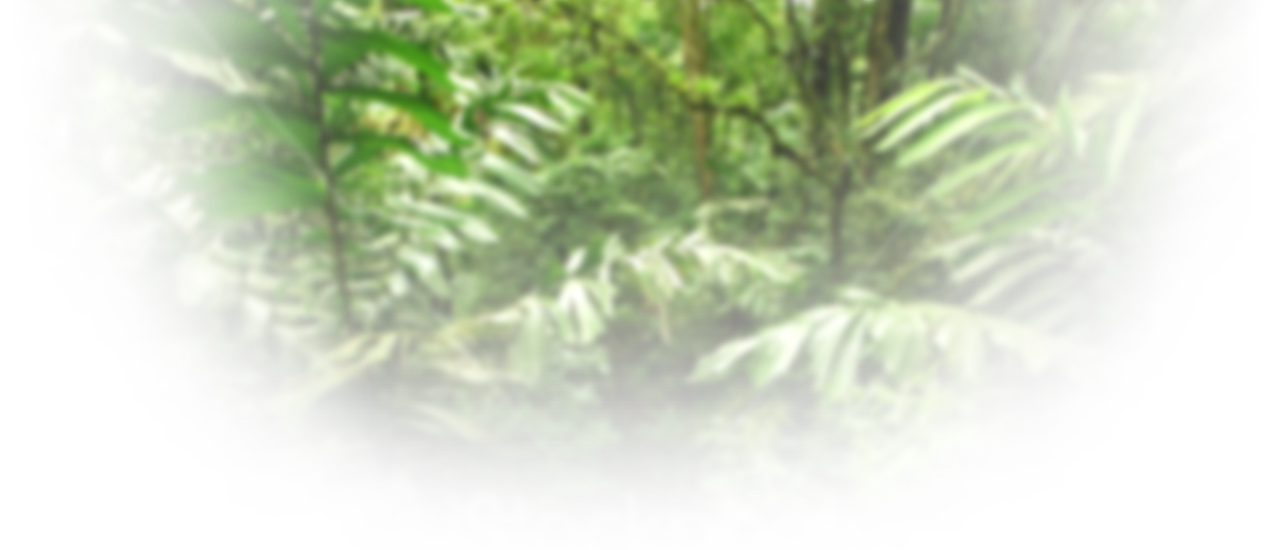NEWS & ARCHIVE
NEWS & ARCHIV
NEWS & ARCHIVE
AMAZONICA TURNS 40
“AMAZONICA is committed to preserving tropical rainforests for humanity.” In pursuit of this goal, we’ve worked with the indigenous peoples of Ecuador to develop innovative solutions.
There are three nonprofit organizations under the AMAZONICA umbrella: the NGO INDIO-HILFE e.V. (founded in 1982), the AMAZONICA foundation (established in 2007), and AMAZONICA Akademie gGmbH (launched in 2015).
This year we’re celebrating the 40th anniversary of our founding.
“We” refers to the founding members in 1982: Mascha Kauka (editor and publicist), her husband Uli Pohl (marketing manager), plus friends and family, all from Munich, Germany.
And that’s how it all began.
“Have you ever been to an area that’s whited out on the map?” asks Mascha and proceeds to tell her story: “While vacationing in Ecuador, one day my husband and I traveled by canoe into one such white patch near the country’s northern border. It’s covered with uncharted virgin rainforest that extends high up into the Andes above the Pacific Ocean. There we had a life-changing encounter with members of the indigenous Chachi people, river nomads that no tourists had ever glimpsed before.


THE PEOPLES OF THE AMAZON WELCOME YOU. EXPERIENCE THE JUNGLE. VISIT OUR AMAZONICA ACADEMY
We proudly present AMAZONICA's very first travel brochure!
This is the next big step in our decade-long history. Finally, the AMAZONICA Academy is open to all visitors and able to offer our indigenous partners a stage for presenting themselves as professional hosts with their own tourism enterprises.
Our charitable organizations, INDIO-HILFE, the AMAZONICA Foundation, and the AMAZONICA Academy have jointly reached an important milestone. In 1999, leaders of the Shuar and Achuar ethnic groups in the Amazon Basin of Ecuador told us:
"We want our young people to have a healthy future on our own territory. Education, income, conservation of nature, and cultural retention are important to us. For this, we need allies."
That has been AMAZONICA's task and this vision has been shared with the Shuar and Achuar.
For 15 years, we developed and tested "the model for modern living and working in the forest" in pilot projects. Community development, the AMAZONICA Academy, and
the opportunity for you to visit this innovative project are all significant milestones throughout our shared journey.
No matter what brings you to us, you will have exceptional and unique experiences; tropical forest ecosystems with mountain and river landscapes, indigenous peoples living in their own territories, regional culture and hospitality, international academic teaching and research, entrepreneurship with sustainable benefits for all – space, calm, harmony, and relaxation.
The jungle, the Shuar, the Achuar, and AMAZONICA welcome you to be a part of this.
Go from reading this brochure to visiting some of the most unique regions on our
beautiful Earth.
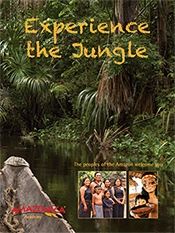

TROPIC ICE - THE AMAZON RAINFOREST AND GREENLAND IN CLIMATE CHANGE
The tropics / the Amazon rainforest in climate dialog with ice / Greenland.
Our AMAZONICA Foundation has gladly supported this production by Barbara Dombrowski. The representatives of the tropical Amazon region are the peoples of the Achuar and Shuar in Ecuador, with which AMAZONICA is working together for 15 years. They want to protect their rainforest, to conserve it, and we help them.
We feel and experience the effects of climate change every day. Where nature is the liveliest, the effects of climate change are felt most intensely: fundamental change of the weather, the seasons, water and drought... and the worst: the extreme species extinction. We do not only know from the newspaper that worldwide every hour four species are wiped out – we are experiencing it on the spot!
Thank you, Barbara, and thank you, Greenlanders, that you create awareness in this joint project about what will destroy mankind!
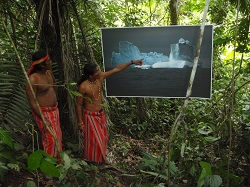

AMAZONICA RESEARCH PROJECT:
A BIRD IS PROTECTING NATURE
The harpy eagle is the largest eagle of Central and South America and is regarded as an important bioindicator for an intact tropical rainforest ecosystem.
Ruth Muñiz is a world-famous Spanish ornithologist who has been exploring and documenting the behavior of this population of eagles for 12 years.
AMAZONICA financed the first scientific work with harpies by Ruth Muñiz in the forests of the Achuar in the Ecuadorian Amazon region in 2002 and 2003.
Since January 2014, AMAZONICA has been financing another research series with Ruth Muñiz. By monitoring the harpy eagle, we want to achieve declaration of their territories as a listed wildlife sanctuary.
In this way, a bird could protect the primeval forest that the Ecuadorian Government wants to sacrifice for economic interests.

© DeLaMontaña

SWEDISH "SUN WATER" FOR THE RAINFOREST
There are many proven ways to sterilize water so that it can be drunk safely. They all work, but the water doesn’t taste good anymore.
Either it doesn’t taste like anything or it tastes like an additive or like the sooty pot from the wood fire... you can’t stand drinking it in large quantities, even if you’re really thirsty.
But that’s all over now, thanks to the SOLVATTEN technology from Sweden: www.solvatten.se
WRainforest dwellers, visitors and the AMAZONICA staff are all thrilled, especially because the process is sustainable, saves costs and we feel good about it.
Up until now, we had to have 5 litre plastic bottles of mineral water for the Academy flown into the rainforest – a crazy procedure, because the empties had to be flown out again.
The "sun water" is a win-win solution, which also shows that it is possible to survive in the jungle without products from Coca-Cola, Nestlé and the rest.
Two Achuar fill a storage tank with ready-to-drink “sun water".
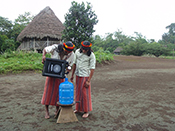

PROTECTING THAT WHICH KEEPS US ALIVE
Why is the primeval forest in Ecuador particularly valuable?
The colder temperatures and drought periods of the last ice age transformed much of the tropical rainforest of South America into a savannah. The former primeval forest survived only in secluded areas scattered like islands across the northern half of the subcontinent (see map).
On one hand, this made the settlement of South America possible by land travel (15000 to 25000 years ago); on the other hand, ecosystems that are many millions of years old were maintained in nature in a particularly sustainable manner. As the climate became warmer and more humid, the forest islands grew back together to form the largest current tropical rainforest.

South America after the last ice age
© Helma Strobel

PUTTING TOGETHER MOVIES IN THE RAINFOREST
We proudly present: "The Revenge of the Fish", the first animation video by indigenous inhabitants of the Amazon rainforest!
Location: AMAZONICA Academy in Yuwints, Shuar territory, Ecuador
Production time: 14 days in August 2013
Filmmakers: Young villagers who took part in the
workshop of the Media Department of the University of Applied Sciences OWL.


CONTRIBUTING TOWARD EDUCATION
Education is the most important topic and top task when it comes to supporting indigenous forest peoples, who are protecting our rainforests:education for those learning their ABCs on up to graduates and training in professions and activities that contribute to each family’s livelihood.
The Ecuadorian State is not only neglecting the indigenous population in the Amazon Basin, but it creates obstacles that are insurmountable, even for the brightest and most willing students.


AMAZONICA ACADEMY’S SUMMER SCHOOL 2012
The group triumphantly returns after a two-day march through the forest and a night under the stars: Professor Christoph Althaus, a lecturer at the Ostwestfalen-Lippe University of Applied Sciences, with students from Germany, Ecuador, and Mexico, led by the best young Shuar guides from Yuwints. Both of the Academy’s locations were booked-out for the August 2012 summer school. Neither educational opportunities nor fun were in short supply, and all of the students would like to return in the future.

© Peter Lidner

THE FUTURE: TRADITION AND MODERN AGE
A snapshot of daily life at the AMAZONICA Academy with the Shuar, who live in the Amazon rainforest area of Ecuador. The young man in the photo using the laptop is Jencham, and he is the first of his people to become an electrical engineer.
He achieved his degree through hard work and financial aid from AMAZONICA. Today, the young Shuar is the best example of how modern learning and traditional wisdom can be combined for a better future – a hope for the indigenous peoples of the Amazon.


ACKNOWLEDGEMENT BY GREENPEACE
ON THE OCCASION OF OUR JUBILEE 1982 – 2012
The AMAZONICA Foundation works successfully in the tropical rainforest for 30 years.
München (AMAZONICA) – 30 years ago, on June 27, 1982, the NGO INDIO-HILFE was created under the leadership of Mascha Kauka. The organization became her lifework. Today, the former publisher continues to serve people and nature through the Foundation AMAZONICA, another organization established by Mascha.
The commitment of the indigenous together with their German allies, is an unique approach: concerned people tirelessly offer their skills and abilities in order to protect the world’s last intact forest ecosystem and its largest source of freshwater. The entire world’s population profits as a result, and as such, it is the responsibility of one and all to support this struggle to protect our Earth.


AMAZONICA: WORLD-WIDE IN FOUR LANGUAGES
In March 2012, German International broadcaster Deutsche Welle aired a world-wide showing of the documentary “Guardians of the Rainforest – Mascha Kauka in the Amazon.”
The release was a multi-lingual repeat in German, English and Spanish of the 2011 airing. Now, the documentary about the foundation’s work with indigenous peoples of the rainforest and German students is also available in Arabic.
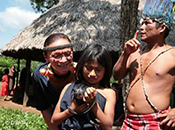

THE GERMAN EMBASSY IN ECUADOR ACKNOWLEDGES THE IMPORTANCE OF OUR WORK
30 years of successful work for Ecuador
It all began in 1980 with a holiday trip to Ecuador. On their tour, Ulrich Pohl and Mascha Kauka, a couple from Munich, visited the northern part of the province of Esmeraldas, the Río Cayapas and its tributaries. “At that time, Esmeraldas was really still emerald green,” Mascha Kauka recalls wistfully. “The jungle spread over the hills all the way down to the famous palm beach on the Pacific. We took a jeep and drove along the sandy trail along the coast until we reached La Tola. We then spent two days in a small outboard motor canoe traveling up river. Soon the map from the Instituto Geográfico Militar (Military Geographic Institute) came to an end in a big white spot – woodland which wasn’t measured at that time. That is where the Chachi people live.”


AMAZONICA at
